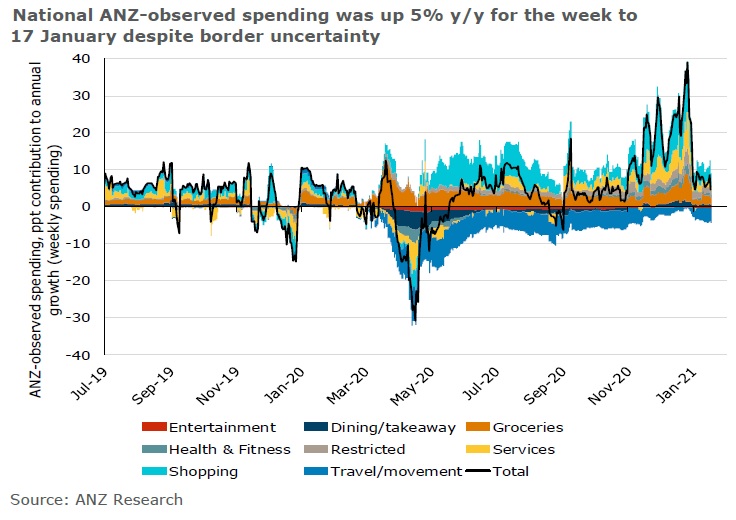-
National ANZ-observed spending was up 5 per cent year-on-year for the week to 17 January. But, within this national total, spending in some areas was weaker as a consequence of COVID-19 restrictions. For instance, spending in Sydney was down 11 per cent year-on-year in this week.
Recent movement restrictions in Australia don’t seem to have slowed total spending growth but may have delayed the rebalancing of spending from the lockdown mix (more physical goods, less services or travel) to the pre-pandemic mix of spending.
"The more targeted, shorter lockdowns and restrictions in 2021 have so far had less impact on employment and household spending than the longer, broader lockdowns of 2020.”
Border uncertainty has reduced travel-related spending (-13 per cent year-on-year for the week to 17 January) while home-related spending grew stronger than pre-pandemic rates. Furniture, office, toys/hobby and outdoor retailers have all had very strong annual growth compared with before the pandemic. Electronics and clothing are much weaker, perhaps an overhang of very strong Black Friday sales.
{CF_IMAGE}
Lockdown impacts in 2021 smaller than last year
The more targeted, shorter lockdowns and restrictions in 2021 have so far had less impact on employment and household spending than the longer, broader lockdowns of 2020.
At its worst in the Stage 4 lockdown, Melbourne spending was down 31 per cent year-on-year, dining/takeaway spending was down 71 per cent year-on-year and shopping was down 47 per cent year-on-year, including -76 per cent year-on-year for clothing.
In contrast, Brisbane’s worst spending declines in 2021 so far are smaller, at -17 per cent year-on-year for total spending, -40 per cent year-on-year for dining/takeaway and -28 per cent year-on-year for shopping including -40 per cent year-on-year for clothing shopping.
ANZ Research expects future lockdowns to have less impact on spending as consumer confidence, employment conditions and economic activity recover. Short, targeted lockdowns tend to have less impact on overall business conditions and turnover than longer, broader lockdowns.
{CF_INFOGRAM}
Pockets of weakness
Uncertainty about interstate and international travel may dampen travel and movement spending (-13 per cent year-on-year for the week to 17 January) for some time. Spending on accommodation in Sydney has been particularly impacted by border restrictions, down 81 per cent year-on-year. But ANZ Research expects a bounce-back as seen in regional Victoria’s extremely strong spending growth on accommodation - up 54 per cent year-on-year - as Melburnians presumably fulfilled pent up demand for travel with local holidays.
Movement restrictions led to a total personal spending decline in Sydney of 11 per cent year-on-year, mainly brought down by travel (-69 per cent year-on-year) and entertainment (-38 per cent year-on-year). However, this may reflect a lack of visitors in Sydney rather than lack of spending by locals.
Brisbane’s decline in spending (-10 per cent year-on-year for the week to 17 January) was broader. Since its mini-lockdown earlier in the month, spending weakness was seen across key categories in Brisbane including shopping, dining/takeaway and travel/movement.
{CF_INFOGRAM}
New South Wales accommodation outside Sydney has not dipped into negative territory despite movement restrictions.
However, Melburnians desperate for new scenery increased their demand for regional Victorian accommodation.
Meanwhile, Brisbane accommodation halved as lockdowns ensued.
{CF_INFOGRAM}
Large home item growth has moderated but a full rebalancing away from home spending has not yet occurred.
Meanwhile, home entertainment growth is still stronger than pre-pandemic levels, except electronics.
{CF_INFOGRAM}
Non-home related retail categories are still in positive territory but fashion sales growth is stronger outside the biggest cities.
{CF_INFOGRAM}
Sydney dining has held up despite fewer visitors than normal.
Interstate border restrictions might be damping Melbourne's dining, but strong intrastate tourism to regional Victoria is providing growth.
Brisbane's lockdown put a halt to dining but didn't bring sales as low as the Melbourne lockdowns.
{CF_INFOGRAM}
Sydney's shopping growth has been matching the rest of NSW since the pandemic took away its visiting customers.
Meanwhile, Melbourne shopping is still stronger than pre-pandemic but any pent up demand from lockdown is likely to be done.
Over in Brisbane, the shopping dip is not as bad as Melbourne's during the September-October Stage 4 lockdown.
{CF_INFOGRAM}
Adelaide Timbrell is Economist and David Plank is Head of Australian Economics at ANZ
The views and opinions expressed in this communication are those of the author and may not necessarily state or reflect those of ANZ.
-
-
-
-
-
-
-
-
anzcomau:Bluenotes/business-finance,anzcomau:Bluenotes/COVID-19
Spending heats up over Summer break
2021-01-29
/content/dam/anzcomau/bluenotes/images/articles/2021/January/TimbrellPlankSummer_banner.jpg
EDITOR'S PICKS
-
New spending data shows the reductions in JobKeeper and JobSeeker aren’t hitting spending levels - yet.
13 October 2020 -
Although spending nationally has stabilised overall, the second lockdown period in Melbourne is leaving a mark.
24 July 2020

